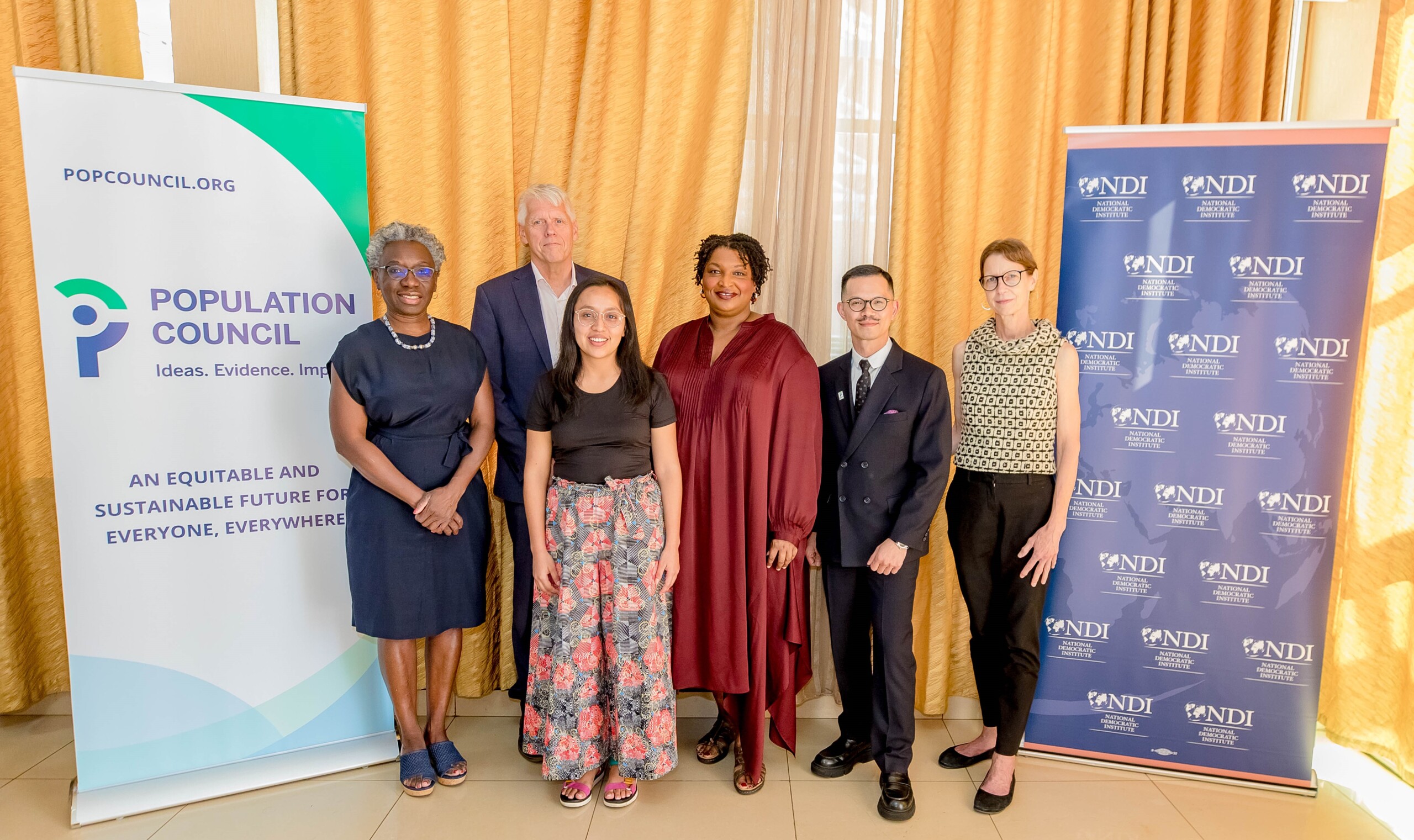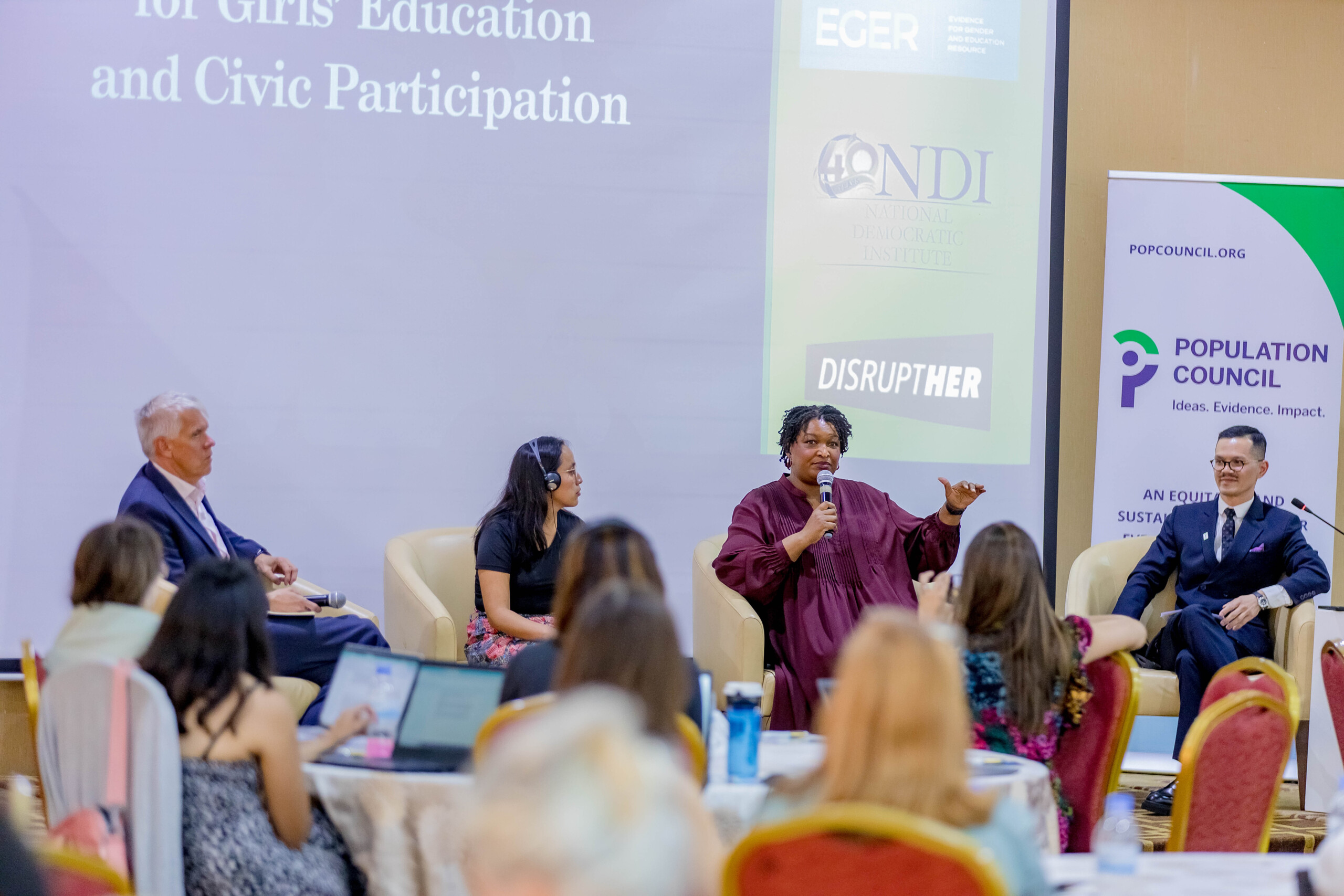
– bell hooks
Voices for Girls’ Education
At Women Deliver 2023 in Kigali, Rwanda, the Population Council and the National Democratic Institute (NDI) jointly hosted a conversation among global feminist leaders about the radical potential of education. The question before them: how education for adolescent girls and young women can be translated into new opportunities for activism, democratic participation, and leadership.
The context for their discussion was the ongoing, widespread global crisis in education—a crisis intertwined with climate disasters, political instability, and conflict. More than half of all children are unable to meet minimum proficiency standards in reading and math, with rates far higher—90 percent—for girls in sub-Saharan Africa. An analysis from the Council’s Evidence for Gender and Education Resource (EGER) program found that only one out of 10 poor girls complete lower secondary school in 28 low and middle-income countries (LMICs). Overall, poor young women are less literate than poor young men in 78% of LMICs.
Speaking to an audience of education activists, funders, government officials, feminists, and NGO leaders, the panel highlighted how shifting those numbers has the potential to help the rising generation meet the challenges before them. The speakers included keynote speaker Stacey Abrams, Torbjörn Pettersson (Swedish International Development Agency), Karla Rax (Na’leb’ak), and Chief Minister David Sengeh (Government of Sierra Leone), moderated by Thoai Ngo, Vice President of Social and Behavioral Science Research at the Population Council.
From L-R: Torbjörn Pettersson, Karla Rax, Stacey Abrams, Thoai Ngo
What follows are a few of the most crucial conclusions from their conversation.
Key Take-Aways
Strengthen Local Organizations
Speaking from her experience leading Na’leb’ak, an indigenous-women-led grassroots organization empowering adolescent girls in rural Guatemalan communities, Karla Rax called on donors to fund local organizations in ways that strengthen their capacities for sustainable change. She pointed to the Council’s Abriendo Oportunidades program as an example—while it draws on international partnerships for resources, the program relies on local leaders to create safe spaces for girls, and has been extremely successful in building their self-efficacy and helping them stay in school. Across 36 communities, 97% of program participants avoided child marriage, 88% opened bank accounts, and 84% completed university or vocational training.
Other panelists agreed, emphasizing the importance of core funding (which means trusting local organizations to determine how best to spend investments) and of building systems that make organizations accountable to the populations they serve rather than to funders. There was a strong consensus around this issue: if we hope to create real change, not only do we need to invest in local organizations to transform education, but we must also allow those organizations to make mistakes—making mistakes is an important way anyone learns—to evolve, and to grow in response to each community’s unique needs.
Investment in Education is a Long-Term Business
For educational transformation to affect lives, build political capital, and strengthen communities, it needs to persist. Completing primary and secondary school takes more than a decade, and successful education programming needs to allow for the complexities of girls’ lives. Some will drop out for a short term; others take on seasonal work or help raise siblings. Schools need to be there when they get back.
There is a link between this kind of long-term thinking and the way that education investment needs to support local organizations. As an illustrative example, Torbjörn Pettersson described his work in northern Afghanistan in the 1980s. Bilateral funders negotiated support for boys’ schools contingent on local community pledges to create schools for girls. A local group of teachers and adults committed to the plan, and when he returned to one village nearly two decades later, not only did its girls still have a school to go to, two of its alumnae had just graduated from Kabul University.
Education Should Create Leaders Not Just Graduates
Gender transformative education programming requires taking risks, the panelists agreed. And there is no leader more willing to take radical risks than one who did not expect to be in a position of power—especially women and girls. Right now, only 31 countries have a female head of state or government, and only 26.5 percent of global parliamentarians are women. Investments in education have the unique potential to create pipelines of talent and aspiration that can shift that imbalance, but the changes we seek need to be substantial, direct, and bold. In a powerful message, Chief Minister David Sengeh shared Sierra Leone’s strong commitment to education and its radical inclusion policy, both in education and in government. Indeed, Sierra Leone has invested 20% of its discretionary budget into education since 2018—coupled with removing school and exam fees, enrollments have increased by 50% and gender parity has been achieved at all school levels. The country recently championed gender-inclusive education through the “Freetown Manifesto”; since the sitting president’s last term, any girl who went to study a STEM subject in higher education receives free tuition. Its parliament has a mandatory youth advisory group, and its Cabinet includes 9 ministers under 40. These are the kinds of legal mandates that are required to give young people, especially women and girls, a real seat at the table and a hand in steering policy.
Education systems cannot do everything on their own. Building girls’ assets means seeing and supporting the “whole-girl.” To achieve education and broader development goals we need to remove the full range of barriers between young women and social, political, and economic power. If girls need access to reproductive healthcare, information can be delivered through schools. Programs that keep girls in school dramatically reduce the risk of child marriage and teenage pregnancy. In addition to building fundamental skills in reading, writing and math, educational interventions can foster confidence, expand networks, and help young women prepare for leadership.
As just one example, NDI is currently working on a context-flexible curriculum called DISRUPTHER, designed to close the confidence gap and equip adolescent girls and young women for civic engagement and political action. Through trainings on networking, voting rights and systems, building campaign teams, creating safe spaces, and more, pilot testing of the module resulted in over 80% of participants feeling more confident and more than 90% having larger political networks.
Stacey Abrams outlined three principles for whole-girl development. First, funders and organizers should invest in girls not just to achieve educational outcomes but to learn and benefit from girls and young women’s input. Second, they should invest in making girls powerful—socially powerful, politically powerful, and economically powerful. And third, they should remember that education—the classroom—is a crucial site of transformation.
A Way Forward
Thoai Ngo called for a new social contract for education that repairs injustices while transforming the future. To respond to today’s education crisis and crises of the future, education systems need to provide children and young people with the ability to problem solve and build alliances rooted in civic engagement, democratic values, and equity.
We are now more prepared than we have ever been to make effective use of development dollars. The Council’s EGER program is just one example of how evidence on what works, and large-scale datasets empower us to create more effective policies and more impactful interventions. EGER’s roadmap for girls’ education illustrates how clearly we can align effective approaches with where the greatest needs are to eliminate gender barriers to schooling, close disparities in education outcomes, and ensure all children are learning.
What we need now is engagement from funders, international partners, governments, and NGOs ready to make transformational commitments to organizations delivering solutions on the ground.
Contact Nicole Haberland to learn more about the Population Council’s education initiative.
Contact Kaimyn Paszko (NDI) to learn more about DISRUPTHER.

